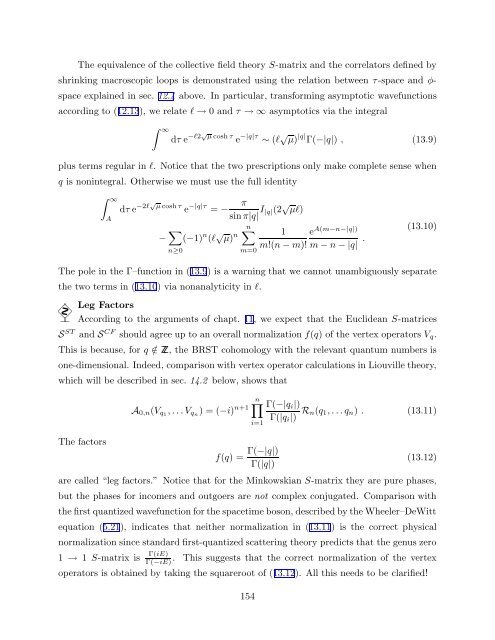arXiv:hep-th/9304011 v1 Apr 5 1993
arXiv:hep-th/9304011 v1 Apr 5 1993
arXiv:hep-th/9304011 v1 Apr 5 1993
Create successful ePaper yourself
Turn your PDF publications into a flip-book with our unique Google optimized e-Paper software.
The equivalence of <strong>th</strong>e collective field <strong>th</strong>eory S-matrix and <strong>th</strong>e correlators defined by<br />
shrinking macroscopic loops is demonstrated using <strong>th</strong>e relation between τ-space and φ-<br />
space explained in sec. 12.4 above. In particular, transforming asymptotic wavefunctions<br />
according to (12.13), we relate l → 0 and τ → ∞ asymptotics via <strong>th</strong>e integral<br />
∫ ∞<br />
dτ e −l2√ µ cosh τ e −|q|τ ∼ (l √ µ) |q| Γ(−|q|) , (13.9)<br />
plus terms regular in l. Notice <strong>th</strong>at <strong>th</strong>e two prescriptions only make complete sense when<br />
q is nonintegral. O<strong>th</strong>erwise we must use <strong>th</strong>e full identity<br />
∫ ∞<br />
A<br />
dτ e −2l√ µ cosh τ e −|q|τ = −<br />
π<br />
sin π|q| I |q|(2 √ µl)<br />
− ∑ (−1) n (l √ µ) n<br />
n≥0<br />
n ∑<br />
m=0<br />
1 e A(m−n−|q|)<br />
(13.10)<br />
m!(n − m)! m − n − |q| .<br />
The pole in <strong>th</strong>e Γ–function in (13.9) is a warning <strong>th</strong>at we cannot unambiguously separate<br />
<strong>th</strong>e two terms in (13.10) via nonanalyticity in l.<br />
<br />
Leg Factors<br />
According to <strong>th</strong>e arguments of chapt. 11, we expect <strong>th</strong>at <strong>th</strong>e Euclidean S-matrices<br />
S ST and S CF should agree up to an overall normalization f(q) of <strong>th</strong>e vertex operators V q .<br />
This is because, for q /∈ Z, <strong>th</strong>e BRST cohomology wi<strong>th</strong> <strong>th</strong>e relevant quantum numbers is<br />
one-dimensional. Indeed, comparison wi<strong>th</strong> vertex operator calculations in Liouville <strong>th</strong>eory,<br />
which will be described in sec. 14.2 below, shows <strong>th</strong>at<br />
The factors<br />
A 0,n (V q1 , . . . V qn ) = (−i) n+1<br />
n ∏<br />
i=1<br />
f(q) = Γ(−|q|)<br />
Γ(|q|)<br />
Γ(−|q i |)<br />
Γ(|q i |) R n(q 1 , . . . q n ) . (13.11)<br />
(13.12)<br />
are called “leg factors.” Notice <strong>th</strong>at for <strong>th</strong>e Minkowskian S-matrix <strong>th</strong>ey are pure phases,<br />
but <strong>th</strong>e phases for incomers and outgoers are not complex conjugated. Comparison wi<strong>th</strong><br />
<strong>th</strong>e first quantized wavefunction for <strong>th</strong>e spacetime boson, described by <strong>th</strong>e Wheeler–DeWitt<br />
equation (5.21), indicates <strong>th</strong>at nei<strong>th</strong>er normalization in (13.11) is <strong>th</strong>e correct physical<br />
normalization since standard first-quantized scattering <strong>th</strong>eory predicts <strong>th</strong>at <strong>th</strong>e genus zero<br />
1 → 1 S-matrix is<br />
Γ(iE)<br />
Γ(−iE) .<br />
This suggests <strong>th</strong>at <strong>th</strong>e correct normalization of <strong>th</strong>e vertex<br />
operators is obtained by taking <strong>th</strong>e squareroot of (13.12). All <strong>th</strong>is needs to be clarified!<br />
154
















